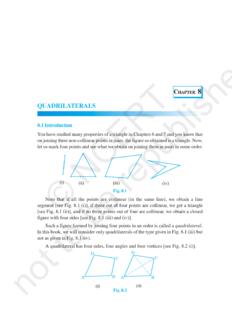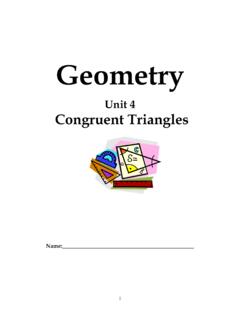Transcription of Honors GEOMETRY
1 1 STANDARDS OF LEARNING CONTENT REVIEW NOTES Honors GEOMETRY 2nd Nine Weeks, 2018-2019 2 OVERVIEW GEOMETRY Content Review Notes are designed by the High School Mathematics Steering Committee as a resource for students and parents. Each nine weeks Standards of Learning (SOLs) have been identified and a detailed explanation of the specific SOL is provided. Specific notes have also been included in this document to assist students in understanding the concepts. Sample problems allow the students to see step-by-step models for solving various types of problems. A section has also been developed to provide students with the opportunity to solve similar problems and check their answers. The document is a compilation of information found in the Virginia Department of Education (VDOE) Curriculum Framework, Enhanced Scope and Sequence, and Released Test items.
2 In addition to VDOE information, Prentice Hall Textbook Series and resources have been used. Finally, information from various websites is included. The websites are listed with the information as it appears in the document. Supplemental online information can be accessed by scanning QR codes throughout the document. These will take students to video tutorials and online resources. In addition, a self-assessment is available at the end of the document to allow students to check their readiness for the nine-weeks test. The GEOMETRY Blueprint Summary Table is listed below as a snapshot of the reporting categories, the number of questions per reporting category, and the corresponding SOLs. 3 4 5 6 Triangle Congruency The student, given information in the form of a figure or statement, will prove two triangles are congruent . Classifying Triangles Acute Obtuse Right A triangle that has 3 acute angles.
3 A triangle that has one obtuse angle. A triangle that has one right angle. Equilateral Equiangular Isosceles Scalene A triangle whose sides are all congruent . A triangle whose angles are all congruent . A triangle with at least two congruent sides. A triangle that has no congruent sides or angles. 7 Triangle Angles Sum Theorem The sum of the measures of the interior angles of a triangle is 180 . Triangle Exterior Angle Theorem The measure of each exterior angle of a triangle is equal to the sum of the measure of its two remote interior angles. Example 1: Solve for the missing angle. Example 2: Solve for x. A + B + C = 180 Z = X + Y y 31 + 82 + = 180 113 + = 180 113 113 =67 25+ +15=3 10 +40=3 10 40=2 10 +10 +10 50=2 =25 This makes sense because W and Z are supplementary, and the sum of W, X, and Y would also be 180.
4 8 congruent Figures congruent Polygons have congruent corresponding parts. When naming congruent polygons, you must list the corresponding vertices in the same order. Example 3: Given , find . Example 4: Given , find . Given , we know that + + =180 28 +90 + =180 118 + =180 =62 Therefore, =62 Given , we know that +6=51 =45 9 Triangle Congruence You can prove that triangles are congruent without having to prove that all corresponding parts are congruent . We will learn 5 postulates that allow us to prove triangle congruence. SSS (Side Side Side) If three sides of one triangle are congruent to the three sides of another triangle, the two triangles are congruent .
5 SAS (Side Angle Side) If two sides and the included angle of one triangle are congruent to two sides and the included angle of another triangle, then the two triangles are congruent . ASA (Angle Side Angle) If two angles and the included side of one triangle are congruent to two angles and the included side of another triangle, then the two triangles are congruent . AAS (Angle Angle Side) If two angles and a non-included side of one triangle are congruent to two angles and a non-included side of another triangle, then the two triangles are congruent . HL (Hypotenuse Leg) If the hypotenuse and a leg of one right triangle are congruent to the hypotenuse and leg of another right triangle, then the triangles 10 are congruent . Example 5: Given: prove : Triangle Congruency 1. The three angles of a triangle measure 58 ,( +41) , (2 +3).
6 Solve for . 2. Find the measure of . Given = 46 3. Can you prove the triangles congruent ? If so, which triangle congruence postulate would you use in each case? a. b. c. d. Statements Reasons Given Reflexive Property of Congruence SAS Postulate Corresponding parts of . Scan this QR code to go to a video tutorial on triangle congruence postulates and proofs. 11 Isosceles and Equilateral Triangles An isosceles triangle is one that has two sides that are the same length. These sides are called legs. The third side is called the base. The isosceles triangle theorem says that if two sides of a triangle are congruent , then the angles opposite of those sides are also congruent . An equilateral triangle is one where all sides are congruent . As a corollary to the isosceles triangle theorem, if a triangle is equilateral then it is also equiangular.
7 Example 6: Find n, given =18 Overlapping Triangles Given that , then The converse of this is also true! Given that , then Given that , then The converse of this is also true! Given that , then Because this is an isosceles triangle, Therefore = . + + =180 18+ + =180 2 +18=180 18 18 2 =162 =81 12 Occasionally you may be asked to prove congruence of two triangles that share common sides or angles, or that overlap. It is often easier to separate the overlap, and to draw them as two separate triangles in order to prove congruence. Example 7: Given: prove : Triangle Congruency 4. Explain why each interior angle of an equilateral triangle must measure 60.
8 5. Given that and =17 , find . 6. What postulate could you use to prove ? Statements Reasons Given Reflexive Property of Congruence AAS Postulate First, draw the triangles separately! >>>> Scan this QR code to go to a video tutorial on congruence in overlapping triangles. 13 Triangle Similarity The student, given information concerning the lengths of sides and/or measures of angles in triangles, will solve problems, including practical problems. This will include a) order the sides by length, given the angle measures; b) order the angles by degree measure, given the side lengths; c) determine whether a triangle exists; and d) determine the range in which the length of the third side must lie. The student, given information in the form of a figure or statement, will prove two triangles are similar.
9 The student will apply the concepts of similarity to two- or three-dimensional geometric figures. This will include d) solving problems, including practical problems, about similar geometric figures. Medians and Altitudes Median A segment that extends from a vertex of a triangle, and bisects the opposite side. Centroid The point where are three medians of a triangle intersect. This is also the center of gravity, or balance point. Altitude The segment that extends from one vertex of a triangle and is perpendicular to the opposite side of the triangle, or the line containing the opposite side. Altitudes can be inside, outside, or directly on a triangle side. 14 Orthocenter The point where the three altitudes of a triangle intersect. An orthocenter can be inside, outside, or directly on a triangle. Triangle Inequalities If two sides of a triangle are not congruent , then the larger angle is opposite of the larger side.
10 The converse of this is also true. If two angles in a triangle are not congruent , then the larger side is opposite the larger angle. Example 1: List the sides of the triangle in order from smallest to largest. The triangle inequality theorem helps us to determine if 3 given lengths could form a triangle. The theorem states that in order for 3 sides to make a triangle, the sum of the lengths of the two shorter sides must be greater than the length of the longest side. Given > > Then > > We know that the smallest side will be across from the smallest angle, and the largest side will be across from the largest angle. This means that is the smallest, and is the largest. Therefore listing from smallest to largest would be: , , 15 Example 2: Can the three lengths of 6 in, 7 in, and 8 in form a triangle? Is 6+7>8 ? Yes, 13>8, therefore these 3 lengths can form a triangle.

